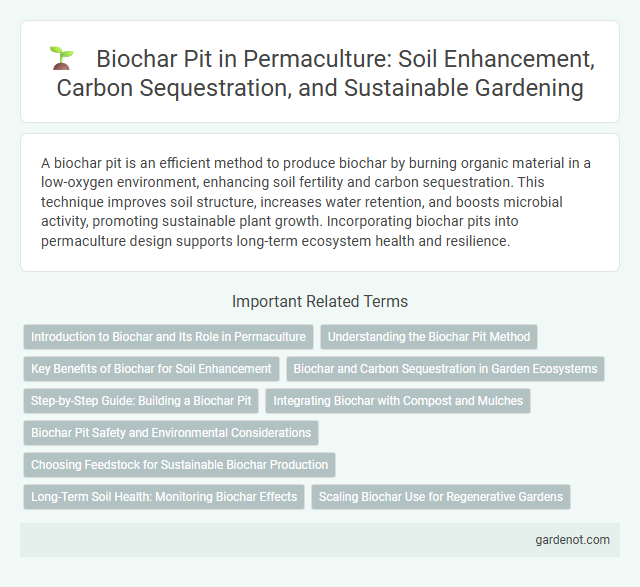A biochar pit is an efficient method to produce biochar by burning organic material in a low-oxygen environment, enhancing soil fertility and carbon sequestration. This technique improves soil structure, increases water retention, and boosts microbial activity, promoting sustainable plant growth. Incorporating biochar pits into permaculture design supports long-term ecosystem health and resilience.
Introduction to Biochar and Its Role in Permaculture
Biochar is a carbon-rich product produced through the pyrolysis of organic materials, serving as a powerful soil amendment in permaculture systems. Its porous structure enhances soil fertility by improving nutrient retention, increasing water-holding capacity, and stimulating beneficial microbial activity. Integrating biochar into permaculture designs supports sustainable agriculture by sequestering carbon and promoting long-term soil health.
Understanding the Biochar Pit Method
The Biochar pit method involves creating a controlled, low-oxygen environment in a dug-out pit to pyrolyze organic biomass into biochar, enhancing soil fertility and carbon sequestration. This technique optimizes nutrient retention and improves water-holding capacity in permaculture systems by stabilizing carbon in the soil for extended periods. Properly managed biochar pits contribute to sustainable agriculture by reducing greenhouse gas emissions and promoting soil microbial activity.
Key Benefits of Biochar for Soil Enhancement
Biochar significantly improves soil fertility by increasing nutrient retention and enhancing microbial activity, leading to healthier plant growth. Its porous structure boosts soil aeration and water-holding capacity, reducing erosion and drought stress. Incorporating biochar also sequesters carbon, promoting sustainable agriculture through long-term soil carbon storage.
Biochar and Carbon Sequestration in Garden Ecosystems
Biochar, created through the pyrolysis of organic materials in a biochar pit, significantly enhances carbon sequestration in garden ecosystems by stabilizing carbon and preventing its release into the atmosphere. Its porous structure improves soil aeration, water retention, and microbial activity, promoting healthier plant growth and increasing soil fertility. Integrating biochar into garden soils supports sustainable carbon cycling and mitigates climate change by locking carbon in a long-lasting, stable form.
Step-by-Step Guide: Building a Biochar Pit
To build a biochar pit, first select a dry, well-ventilated area and dig a rectangular pit approximately 3 feet long, 2 feet wide, and 2 feet deep. Fill the pit with dry biomass material such as wood chips, crop residues, or pruning waste, then ignite it to initiate slow pyrolysis, controlling airflow by partially covering the pit to maintain low oxygen levels. Once smoldering subsides, extinguish the fire by sealing the pit with soil or water to cool and solidify the biochar, which can then be incorporated into soil to improve fertility and carbon sequestration.
Integrating Biochar with Compost and Mulches
Biochar enhances soil fertility by improving nutrient retention and microbial activity when integrated with compost and mulches in permaculture systems. Combining biochar with nutrient-rich compost accelerates decomposition and stabilizes organic matter, resulting in long-lasting soil health benefits. Applying mulches over biochar-amended soil conserves moisture and supports beneficial microorganisms, creating a synergistic environment for plant growth.
Biochar Pit Safety and Environmental Considerations
Biochar pits require careful management to prevent air pollution and reduce fire risks by controlling oxygen flow during the pyrolysis process. Proper site selection away from water bodies is essential to avoid contamination from leachate and maintain soil quality. Ensuring adequate ventilation and using protective gear minimize exposure to harmful gases like carbon monoxide, enhancing biochar pit safety for operators and surrounding ecosystems.
Choosing Feedstock for Sustainable Biochar Production
Selecting the right feedstock for sustainable biochar production is critical for maximizing soil enhancement and carbon sequestration benefits in permaculture systems. Ideal feedstocks include agricultural residues like corn stalks, rice husks, and pruning waste, which are renewable and have low contamination risk, ensuring high-quality biochar. Using locally sourced, untreated biomass reduces environmental impact and supports circular resource management within permaculture design.
Long-Term Soil Health: Monitoring Biochar Effects
Biochar pits enhance long-term soil health by improving nutrient retention, water holding capacity, and microbial activity over time. Monitoring biochar effects involves assessing soil pH, organic matter content, and microbial biomass to evaluate sustainability. Consistent soil testing ensures biochar applications support resilient ecosystems and increased crop productivity.
Scaling Biochar Use for Regenerative Gardens
Biochar pits enable efficient production of biochar, enhancing soil fertility, water retention, and carbon sequestration in regenerative gardens. Scaling biochar use involves integrating pit designs tailored to garden size and biomass availability, optimizing pyrolysis conditions for maximum carbon stability. Widespread adoption of biochar pits supports sustainable soil management and climate-resilient permaculture systems.
Biochar pit Infographic

 gardenot.com
gardenot.com